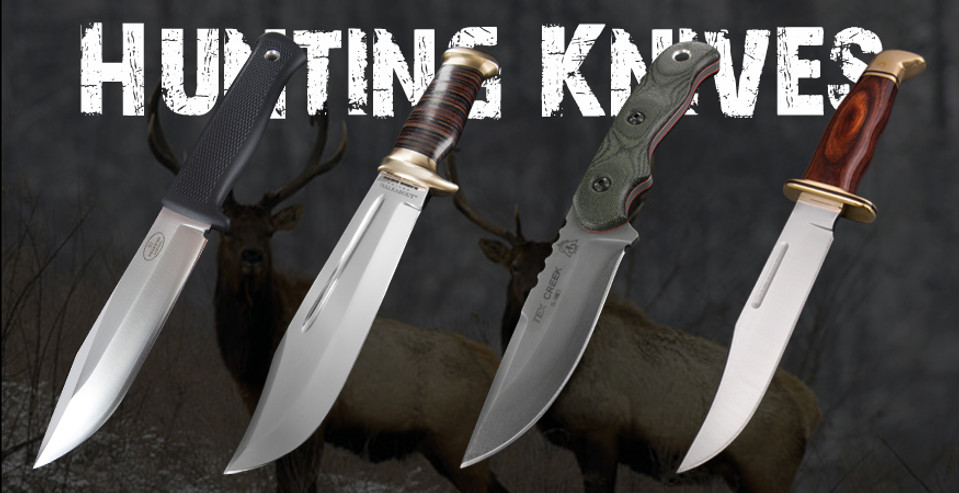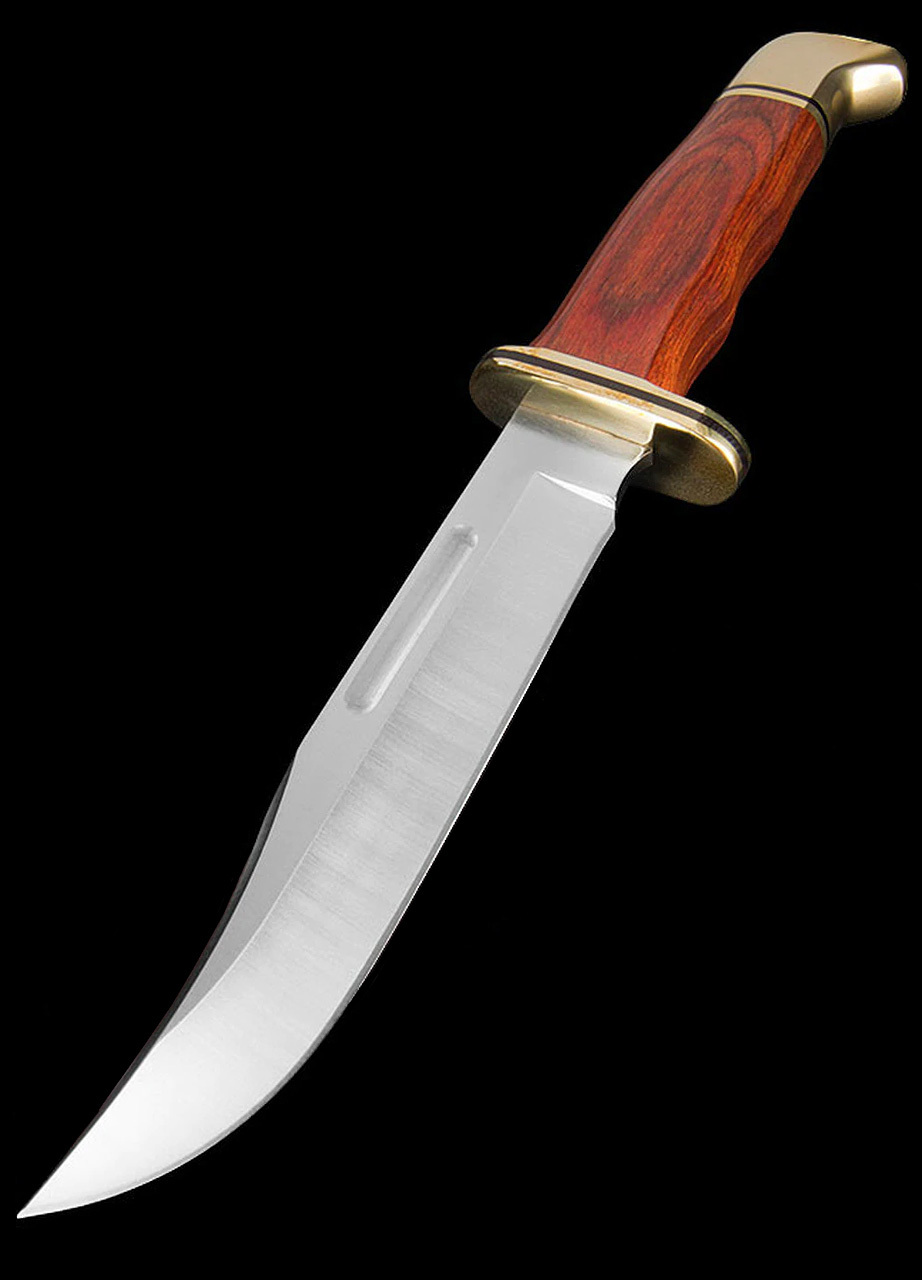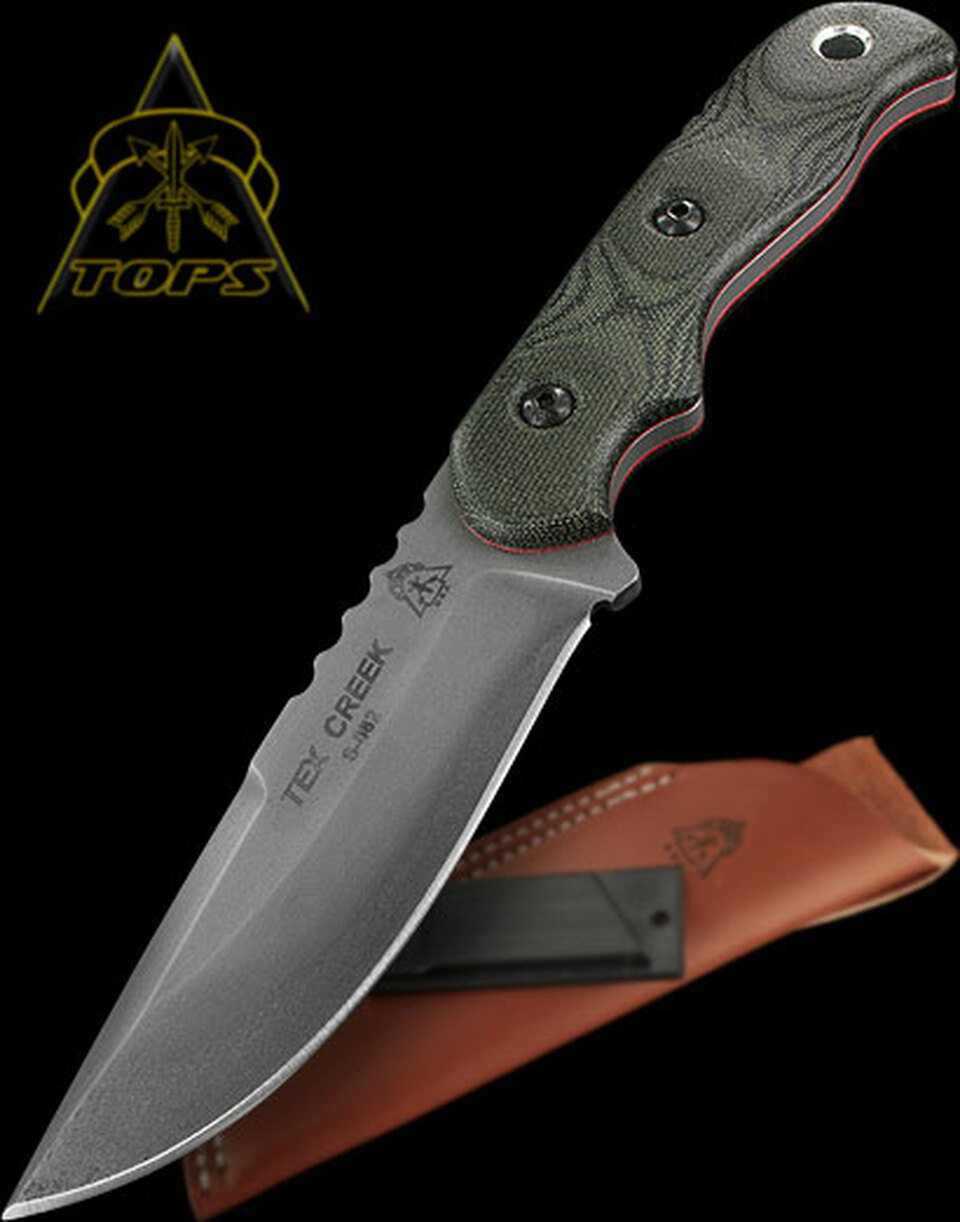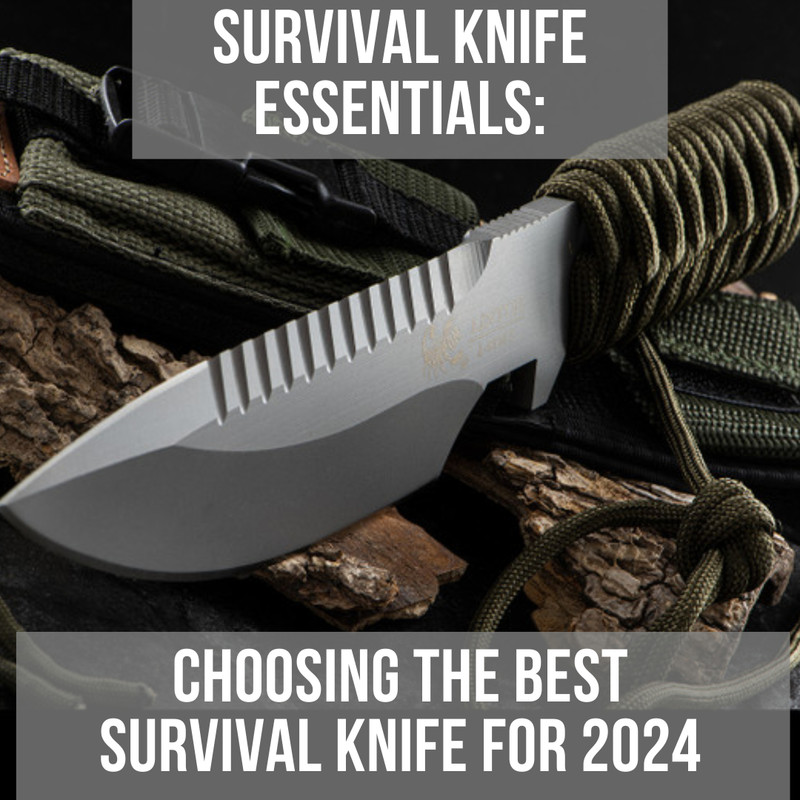Why do I need a hunting knife? What makes them different?
Posted by HH on 25th Jul 2015
This post will be your go to guide when it comes to hunting knives. We are going to take you step by step through the process of what a hunting knife is, and everything else you want and need to know about hunting knives as well as how to choose the perfect one!
A quality hunting knife will be versatile enough to do everything the average hunter needs and a little bit more. When you’re choosing a hunting knife, it’s important to consider how you’ll use it and the type of game you plan to hunt. Being realistic is important, as someone hunting Deer may need a different needs for their knife compared to someone hunting rabbits.
What is a Hunting Knife exactly?
Let’s start with the basics. A hunting knife is a knife used during hunting for preparing the game to be used as food. This can include but not limited to skinning and boning. There is a little more too it than that, and we will break it down more later in the article, so keep reading!
What makes them different from ordinary knives?
Hunting knives are traditionally designed for cutting, and usually have a single sharpened edge. The blade is slightly curved on most models (we’ve added some of our favourite hunting knives throughout the article, these will show you what we mean), and some hunting knives may have a blade that has both a curved portion for skinning, and a straight portion for cutting slices of meat. You’ll also find that some blades incorporate a ‘Guthook’ (we’ve found that these are commonly found amongst fishermen).
Fixed Vs Folding
Realistically with a good folding knife you should have no problem using it for hunting. However, we recommend a fixed blade 99% of the time. Why? Well there are a number of advantages. Generally fixed blades are stronger, you also don’t have to worry about the knife potentially closing in on you. We’ve also found that there is often a misconception that fixed blades mean less control because they are bigger. This isn’t the case. There are some absolutely quality fixed blades out there that not only offer strength but control. For some of you a folding knife may be a better option. Sure they generally aren’t as strong, but they are lighter and easier to carry. The choice is yours. When looking at a fixed blade, it’s also worth considering whether the knife is of full, partial or half tang construction, as this can impact on the strength, weight and durability of the knife.
When you’ve made the choice between fixed and folding, it’s time to choose the blade for your needs. There are several types of knives available, and the choice boils down to personal preference and the type of game you typically hunt. There are three common types of blades; clip point, drop point and skinning blade.
Clip Point, Drop Point, Skinning
The clip point knife blade is thin with a well-defined point. The blade itself is relatively flat. This knife is versatile enough to be used for general camp chores and specialised hunting jobs, including field dressing and skinning. The hunter who wants a good all-around knife should consider the clip point blade.
The drop point knife is a specialised hunting knife. It’s used to dress the animal and skin it, but shouldn’t be used to cut rope or twigs, or do other general camping-related chores. The blade of a drop point knife is thick and curved. The point is not defined, which makes it easy to use the entire blade for skinning. Using the entire blade not only speeds up the process, but reduces the risk of damaging the meat. Because it doesn’t have a distinct point, you’re less likely to tear into the meat while you’re skinning the animal. The blade’s robust design allows the hunter to use the knife for gutting and other field cleaning duties.
Skinning blades are designed to skin big game animals. The blade quickly and neatly separates the skin from the meat of large game. Although the blade is specifically made for skinning, the knife can also be used for other hunting chores.
Once you’ve decided among the clip point, drop point and skinning blades, you should consider whether you want the blade to have serrations. Serrations allow you to use the blade for heavy jobs, such as splitting through a rib cage, and typically take up only a small portion of the blade’s length.
Some may tell you that size is everything . .
Come on who doesn’t like a big blade, but bigger isn’t always better contrary to what some people may say. With a bigger knife doing precise jobs such as cleaning and preparing game will be more difficult compared to a smaller knife that’s much easier to control.
Quality is key!
Quality hunting knives typically have either carbon steel or stainless steel blades. Each type of blade has advantages and disadvantages. Carbon steel blades rust, so they require special treatment. Regular use is the best way to prevent rust from forming on the blade, but you can also coat the blade to prevent rust. To coat your carbon steel blade, clean your blade thoroughly, allow it to dry completely, then apply a wax that contains silicon. Carbon steel blades tend to be easier to sharpen and remain sharp for longer than a stainless steel blade.
Stainless steel knife blades are rust resistant. This makes them extremely popular with hunters who hunt in areas with rainy conditions. However, stainless steel knives can be more difficult to sharpen and more expensive than carbon steel knives.
If you’re interested in a folding blade knife, examine the pivot point thoroughly. You should consider a something like Frog Lube for the pivot, which is 100% natural and will look after the joint. This is the area that will be under pressure as you open and shut the blade. Also, check the locking mechanism because if this fails in use, it can cause a nasty accident.
Whether you choose a fixed or folding blade knife, the handle should be sturdy and feel relatively heavy in your hand. Examine the area where the knife’s blade enters the handle — this can be a point of weakness. If you choose a folding blade knife, check how the blade folds into the handle. Does it line up and move relatively easy, or do you have to force it? A quality knife should move with ease.
Look after your knife fool!
Proper care will extend the life of your hunting knife. You’ll normally store your fixed blade knife in a sheath (common sheaths are KYDEX and Leather), but if you don’t plan on using it for a while, you’ll need special long-term storage solutions. For long-term storage, wrap your clean and dry knife in plain paper, and store that package in a plastic bag. Add a package of desiccant to the bag to absorb any moisture.
It’s also important to keep your knife sharp. A sharp blade cuts easily, which will prevent you from accidentally cutting yourself by trying to force a dull blade. You can have your knife blade professionally sharpened, but it’s actually an easy project to complete yourself. Just get a knowledgeable person to show you how to sharpen your hunting knife for the first time (or watch one of the hundreds of YouTube videos out there), and you’ll be able to do it yourself after that. It’s important to learn how to do it from an expert because the wrong technique can actually dull your hunting blade.
Day-to-day care is the best way to extend the life of your hunting knife. Clean the blade and handle thoroughly after use, using a product made specifically for the job. A quick wipe down in the field is a good idea after you use your knife, but it doesn’t replace a thorough cleaning when you arrive home. Use a product made specifically for your knife’s material. There are many multifunctional cleaners that can be used on metal, wood and leather. These products make it easier to clean your knife because you don’t have to worry about ruining your handle when you clean your blade.
Often these commercial cleaners also work as a lubricant and protector. Using all-in-one products can save a great deal of time for you in caring for your knife. Proper care of your hunting knife will extend its life and reduce your risk of accidentally cutting yourself. A sharp blade that’s securely set in the handle is the safest blade to use. At Heinnie Haynes we sell a big range of knife care products so it’s well worth a look if you are seriously interested in looking after you knife, whether it’s a hunting knife or not!
More than just a hunting knife
Although a knife is an extremely important tool for any hunter, it’s not the only tool that a hunter should carry. An experienced hunter would not leave for a hunting trip without a solid set of hunting knives and related tools. These hunting knife sets include knives, saws, axes and more, which all may be required at different points during the hunt. The choice of hunting knife set is different for each hunter, as each hunter will differ according to what they hunt and their level of hunting experience. If you’re interested in finding out more about all the knives and tools you’ll need for hunting, keep your eyes peeled for our next hunting post!
Top hunting knives at Heinnie Haynes
In this section we are going to look at some of the top selling hunting knives here at Heinnie. We aren’t going to talk you through all the specifications of each knife, but instead will talk you through the look, feel and usability of the knife. If you want to know more about or want to purchase the knife in question (or any of the other knives shown in this post) please click on the picture to be taken to the specific page of the knife in question.
The knives we are focussing on are the: Buck Special, Falkniven S1, Down Under Walkabout & TOPS TEX Creek Hunter.
Buck Special
From the leather sheath to the knife itself this is a stunning tool. When you take it out the box it just has that really nice proper leather smell. You know, the one that let’s you know this is the real deal kind of smell. The knife is a dual hollow grind clip point, which as we’ve mentioned previously makes it ideal for a hunters tool. The construction of the blade is full tang, which gives the knife not only great balance but also extra strength, which is great for the toughest of tasks. The design is simply flawless. The blade is shiny and sharp out of the box. Then moving down to the handle which has been designed to me used but also look awesome. There is a hidden rivet in the handle too so there are no breaks in the smoothness of it. Back to the sheath. The final thing we like about this is that there is an extra leather strap to help secure the knife in place (really useful if you tend to lose or drop things!).
Fallkniven F1
Honestly it’s the least good looking out of the 4 but what have looks got to do with it? The ergonomics on this thing are sensational. It’s designed to be a knife that’s not only good at the business end, but also a really pleasure to use. It’s not the biggest of knives either, but it definitely has the feel of a much bigger blade in terms of the strength it holds. Like the Buck Special it has a full tang construction, however the balance point on this knife is slightly further towards the butt of the knife. The handle material is extremely grippy and adds not only comfort but also aids in the control of the knife. The final thing to note of this knife is the blade is a full flat grind (though people do re-grind into Scandi) which gives this knife a lot of versatility to not only be used as a specific hunting knife.
TOPS Tex Creek Hunter
The Tex Creek has a similar grind to Fallkniven F1. Which as wit the Fallkniven makes it a versatile and good all round hunting knife. What makes this knife stand out from the rest is not only its distinctive appearance with the riverwash/stonewash finish, but the addition on a finger chill for precision work. This is a great asset for any knife, especially a hunter looking at working with small game. On the top of the handle there is also a good amount go gimping which enhances grip both when using the finger chill and not. Like all the knives we’ve seen so far this is a also a full tang knife, and like the Fallkniven F1 the balance point is slightly towards the butt of the knife compared to the Buck Special. Looking at the sheath. We love the leather sheath again it has that proper leather look, feel and smell, the only problem it that the knife isn’t as secure in this sheath as it is in the others.
Down Under Walkabout
This is the biggest of the four knives we are focusing on today. It’s a heavy knife too but that’s not a bad thing necessarily! The blade itself is striking not only because of the Bowie shape but because it’s blindly shiny. It’s not too much different from the Buck Special in terms of shape and style. The handle does differ. The feel of it is really nice, and the shaping of the belly makes for really comfortable holding. The knife is well balanced too for a knife of it’s size, and really although it’s a big knife it doesn’t necessarily have the weight you may expect. Just because it’s lighter though, don’t expect any less bang for your buck! It’s a knife with a purpose in mind.










